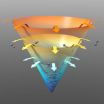(Press-News.org) LA JOLLA, Calif., December 19, 2012 – Amyotrophic lateral sclerosis (ALS), also known as Lou Gehrig's disease, is untreatable and fatal. Nerve cells in the spinal cord die, eventually taking away a person's ability to move or even breathe. A consortium of ALS researchers at multiple institutions, including Sanford-Burnham Medical Research Institute, Brigham and Women's Hospital, and the University of Massachusetts Medical School, tested transplanted neural stem cells as a treatment for the disease. In 11 independent studies, they found that transplanting neural stem cells into the spinal cord of a mouse model of ALS slows disease onset and progression. This treatment also improves host motor function and significantly prolongs survival. The transplanted neural stem cells did not benefit ALS mice by replacing deteriorating nerve cells. Instead, neural stem cells help by producing factors that preserve the health and function of the host's remaining nerve cells. They also reduce inflammation and suppress the number of disease-causing cells in the host's spinal cord. These findings, published December 19 in Science Translational Medicine, demonstrate the potential neural stem cells hold for treating ALS and other nervous system disorders.
"While not a cure for human ALS, we believe that the careful transplantation of neural stem cells, particularly into areas that can best sustain life—respiratory control centers, for example—may be ready for clinical trials," Evan Y. Snyder, M.D., Ph.D., director of Sanford-Burnham's Stem Cell and Regenerative Biology Program and senior author of the study.
Neural stem cells
In this study, researchers at multiple institutions conducted 11 independent studies to test neural stem cell transplantation in a well-established mouse model of ALS. They all found that this cell therapy reduced the symptoms and course of the ALS-like disease. They observed improved motor performance and respiratory function in treated mice. Neural stem cell transplant also slowed the disease's progression. What's more, 25 percent of the treated ALS mice in this study survived for one year or more—roughly three to four times longer than untreated mice.
Neural stem cells are the precursors of all brain cells. They can self-renew, making more neural stem cells, and differentiate, becoming nerve cells or other brain cells. These cells can also rescue malfunctioning nerve cells and help preserve and regenerate host brain tissue. But they've never before been studied extensively in a good model of adult ALS.
How neural stem cells benefit ALS mice
Transplanted neural stem cells helped the ALS mice, but not for the obvious reason—not because they became nerve cells, replacing those missing in the ALS spinal cord. The biggest impact actually came from a series of other beneficial neural stem cell activities. It turns out neural stem cells produce protective molecules. They also trigger host cells to produce their own protective molecules. In turn, these factors help spare host nerve cells from further destruction.
Then a number of other positive events take place in treated mice. The transplanted normal neural stem cells change the fate of the host's own diseased neural stem cells—for the better. This change decreases the number of toxin-producing, disease-promoting cells in the host's spinal cord. Transplanted neural stem cells also reduce inflammation.
"We discovered that cell replacement plays a surprisingly small role in these impressive clinical benefits. Rather, the stem cells change the host environment for the better and protect the endangered nerve cells," said Snyder. "This realization is important because most diseases are now being recognized as multifaceted in their cause and their symptoms—they don't involve just one cell type or one malfunctioning process. We are coming to recognize that the multifaceted actions of the stem cell may address a number of these disease processes."
INFORMATION:
This research was funded by Project ALS, California Institute for Regenerative Medicine, the U.S. National Institutes of Health (National Institute of Neurological Disorders and Stroke grants R21NS053935, 1RC2NS070342-01, 1RC1NS068391-01, R01NS050557-05, U01NS05225-03), U.S. Department of Veterans Affairs, Christopher Reeve Foundation/American Paralysis Association, Sanford Children's Health Research Center, Zinberg Foundation, ALS Therapy Alliance, ALS Association, Angel Fund, Al-Athel Foundation, Pierre L. deBourgknect ALS Research Foundation, P2ALS, and HeadNorth.
The study was co-authored by Yang D. Teng, Brigham and Women's Hospital, Harvard Medical School, Veterans Affairs Boston Healthcare System; Susanna C. Benn, Massachusetts General Hospital; Steven N. Kalkanis, Harvard Medical School, Massachusetts General Hospital; Jeremy M. Shefner, State University of New York, Syracuse; Renna C. Onario, Harvard Medical School, Veterans Affairs Boston Healthcare System, Children's Hospital-Boston; Bin Cheng, Columbia University; Mahesh B. Lachyankar, Harvard Medical School, Children's Hospital-Boston; Michael Marconi, Children's Hospital-Boston, Beth Israel Deaconess Medical Center; Jianxue Li, Beth Israel Deaconess Medical Center; Dou Yu, Harvard Medical School, Veterans Affairs Boston Healthcare System; Inbo Han, Harvard Medical School, Veterans Affairs Boston Healthcare System; Nicholas J. Maragakis, Johns Hopkins University; Jeronia Lládo, Johns Hopkins University; Kadir Erkmen, Harvard Medical School, Children's Hospital-Boston; D. Eugene Redmond Jr., Yale University School of Medicine; Richard L. Sidman, Harvard Medical School, Beth Israel Deaconess Medical Center; Serge Przedborski, Columbia University; Jeffrey D. Rothstein, Johns Hopkins University; Robert H. Brown Jr., Massachusetts General Hospital, University of Massachusetts Medical School; Evan Y. Snyder, Harvard Medical School, Children's Hospital-Boston, Beth Israel Deaconess Medical Center, and Sanford-Burnham Medical Research Institute.
About Sanford-Burnham Medical Research Institute
Sanford-Burnham Medical Research Institute is dedicated to discovering the fundamental molecular causes of disease and devising the innovative therapies of tomorrow. The Institute consistently ranks among the top five organizations worldwide for its scientific impact in the fields of biology and biochemistry (defined by citations per publication) and currently ranks third in the nation in NIH funding among all laboratory-based research institutes. Sanford-Burnham utilizes a unique, collaborative approach to medical research and has established major research programs in cancer, neurodegeneration, diabetes, and infectious, inflammatory, and childhood diseases. The Institute is especially known for its world-class capabilities in stem cell research and drug discovery technologies. Sanford-Burnham is a U.S.-based, non-profit public benefit corporation, with operations in San Diego (La Jolla), California and Orlando (Lake Nona), Florida. For more information, news, and events, please visit us at sanfordburnham.org.
Transplanted neural stem cells treat ALS in mouse model
In 11 independent studies, a consortium of ALS researchers shows that transplanting neural stem cells into the spinal cord of an ALS mouse model slows disease onset and progression, improves motor function, and significantly prolongs survival
2012-12-20
ELSE PRESS RELEASES FROM THIS DATE:
Unraveling the threads: Simplest cotton genome offers clues for fiber improvements
2012-12-20
From the stockings decorating mantles to the new outfits in display windows calling to shoppers, cotton is woven into the fabric of the holiday season. For bioenergy researchers, however, fiber composition matters more than color and texture as each cotton strand is composed of more than two dozen coils of cellulose, a target biomass for next-generation biofuels.
In the December 20, 2012 edition of Nature, an international consortium of researchers from 31 institutions including a team from the U.S. Department of Energy Joint Genome Institute (DOE JGI) present a high-quality ...
Occasional family meals enough to boost kids' fruit and veg intake
2012-12-20
Eating meals together as a family, even if only once or twice a week, increases children's daily fruit and vegetable intake to near the recommended 5 A Day, according to researchers at the University of Leeds.
The study of primary school-aged children, funded by the National Institute for Health Research Public Health Research (NIHR PHR) Programme, also suggests parental consumption of fruit and vegetables and cutting up portions of these foods boosted children's intake. It is published today in the British Medical Journal's Journal of Epidemiology & Community Health.
Overall, ...
Stars reveal the secrets of looking young
2012-12-20
Globular clusters are spherical collections of stars, tightly bound to each other by their mutual gravity. Relics of the early years of the Universe, with ages of typically 12-13 billion years (the Big Bang took place 13.7 billion years ago), there are roughly 150 globular clusters in the Milky Way and they contain many of our galaxy's oldest stars.
But while the stars are old and the clusters formed in the distant past, astronomers using the MPG/ESO 2.2-metre telescope and the NASA/ESA Hubble Space Telescope have found that some of these clusters are still young at heart. ...
How to look young when you're not
2012-12-20
Globular clusters are spherical collections of stars, tightly bound to each other by their mutual gravity. Relics of the early years of the Universe, with ages of typically 12-13 billion years (the Big Bang took place 13.7 billion years ago), there are roughly 150 globular clusters in the Milky Way and they contain many of our galaxy's oldest stars.
But while the stars are old and the clusters formed in the distant past, astronomers using the NASA/ESA Hubble Space Telescope and the MPG/ESO 2.2-metre telescope at the ESO La Silla Observatory have found that some of these ...
JILA physicists achieve elusive 'evaporative cooling' of molecules
2012-12-20
Achieving a goal considered nearly impossible, JILA physicists have chilled a gas of molecules to very low temperatures by adapting the familiar process by which a hot cup of coffee cools.
Evaporative cooling has long been used to cool atoms, at JILA and elsewhere, to extraordinarily low temperatures. The process was used at JILA in 1995 to create a then-new state of matter, the Bose-Einstein condensate (BEC) of rubidium atoms. The latest demonstration, reported in the Dec. 20, 2012, issue of Nature,* marks the first time evaporative cooling has been achieved with molecules—two ...
Scientists develop technique to help prevent inherited disorders in humans
2012-12-20
NEW YORK, NY (December 19, 2012) – A joint team of scientists from The New York Stem Cell Foundation (NYSCF) Laboratory and Columbia University Medical Center (CUMC) has developed a technique that may prevent the inheritance of mitochondrial diseases in children. The study is published online today in Nature.
Dieter Egli, PhD, and Daniel Paull, PhD, of the NYSCF Laboratory with Mark Sauer, MD, and Michio Hirano, MD, of CUMC demonstrated how the nucleus of a cell can be successfully
transferred between human egg cells. This landmark achievement carries significant implications ...
Scientists establish link between inflammatory process and progression of Alzheimer's disease
2012-12-20
WORCESTER, MA — An international team of researchers from the University of Massachusetts Medical School, the University of Bonn and the Center for Advanced European Studies and Research in Germany have shown that a well-known immune and inflammatory process plays an important role in the pathology of Alzheimer's disease. This process, which results in the mature production of the pro-inflammatory cytokine called interleukin-1 beta (IL-1B) and is involved in the body's defense against infection, has also been established as a clinical target for rheumatoid arthritis. The ...
NYSCF and CUMC scientists develop scientific technique to help prevent inherited disorders in humans
2012-12-20
NEW YORK, NY (December 19, 2012) – A joint team of scientists from The New York Stem Cell Foundation (NYSCF) Laboratory and Columbia University Medical Center (CUMC) has developed a technique that may prevent the inheritance of mitochondrial diseases in children. The study is published online today in Nature.
Dieter Egli, PhD, and Daniel Paull, PhD, of the NYSCF Laboratory with Mark Sauer, MD, and Michio Hirano, MD, of CUMC demonstrated how the nucleus of a cell can be successfully transferred between human egg cells. This landmark achievement carries significant implications ...
Asthmatics at increased risk of pulmonary embolism
2012-12-20
People with asthma have an increased risk of pulmonary embolism, according to new research.
A new study, published online ahead of print today (20 December 2012) in the European Respiratory Journal, looked at whether people with moderate or severe asthma had an increased risk of developing deep vein thrombosis, or pulmonary embolism.
Pulmonary embolism is when the main artery of the lung or the bronchi becomes blocked. It usually results from deep vein thrombosis; a blood clot in the veins, which can break off and move around the body to the lung.
Previous research ...
Pics, shoots and leaves: Ecologists turn digital cameras into climate change tools
2012-12-20
As digital cameras become better and cheaper, ecologists are turning these ubiquitous consumer devices into scientific tools to study how forests are responding to climate change. And, they say, digital cameras could be a cost-effective way of visually monitoring the spread of tree diseases. The results – which come from 38,000 photographs – are presented at this week's British Ecological Society's Annual Meeting at the University of Birmingham.
Because trees fix carbon dioxide (CO2) from the atmosphere and store carbon as biomass and soil organic matter, forests play ...
LAST 30 PRESS RELEASES:
Plant hormone allows lifelong control of proteins in living animal for first time
Swedish freshwater bacteria give new insights into bacterial evolution
Global measures consistently underestimate food insecurity; one in five who suffer from hunger may go uncounted
Hidden patterns of isolation and segregation found in all American cities
FDA drug trials exclude a widening slice of Americans
Sea reptile’s tooth shows that mosasaurs could live in freshwater
Pure bred: New stem cell medium only has canine components
Largest study of its kind highlights benefits – and risks – of plant-based diets in children
Synergistic effects of single-crystal HfB2 nanorods: Simultaneous enhancement of mechanical properties and ablation resistance
Mysterious X-ray variability of the strongly magnetized neutron star NGC 7793 P13
The key to increasing patients’ advance care medical planning may be automatic patient outreach
Palaeontology: Ancient tooth suggests ocean predator could hunt in rivers
Polar bears may be adapting to survive warmer climates, says study
Canadian wildfire smoke worsened pediatric asthma in US Northeast: UVM study
New UBCO research challenges traditional teen suicide prevention models
Diversity language in US medical research agency grants declined 25% since 2024
Concern over growing use of AI chatbots to stave off loneliness
Biomedical authors often call a reference “recent” — even when it is decades old, analysis shows
The Lancet: New single dose oral treatment for gonorrhoea effectively combats drug-resistant infections, trial finds
Proton therapy shows survival benefit in Phase III trial for patients with head and neck cancers
Blood test reveals prognosis after cardiac arrest
UBCO study finds microdosing can temporarily improve mood, creativity
An ECOG-ACRIN imaging study solves a long-standing gap in metastatic breast cancer research and care: accurately measuring treatment response in patients with bone metastases
Cleveland Clinic presents final results of phase 1 clinical trial of preventive breast cancer vaccine study
Nationally renowned anesthesiology physician-scientist and clinical operations leader David Mintz, MD, PhD, named Chair of the Department of Anesthesiology at the UM School of Medicine
Clean water access improves child health in Mozambique, study shows
Study implicates enzyme in neurodegenerative conditions
Tufts professor named Fellow of the National Academy of Inventors
Tiny new device could enable giant future quantum computers
Tracing a path through photosynthesis to food security
[Press-News.org] Transplanted neural stem cells treat ALS in mouse modelIn 11 independent studies, a consortium of ALS researchers shows that transplanting neural stem cells into the spinal cord of an ALS mouse model slows disease onset and progression, improves motor function, and significantly prolongs survival



